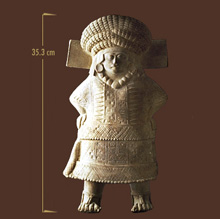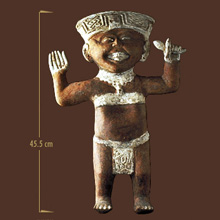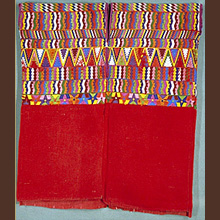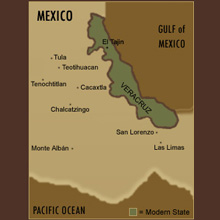let the objects speak
Classic Veracruz - Formally Dressed 'Veracruz Lady'

The elaborate dress and hair of this figure from Mexico's Gulf Coast show that she is a member of the elite. Her coiffure is bound in woven cotton cords that are probably framed in a traditional headdress of amate (Mexican fig tree) paper with sticks. The ear ornaments and necklace that she wears, possibly of jade, also denote her elite status. Even her sandals, probably of leather or woven fibre, tell us that she is of high status, because not everyone in Veracruz society wore footgear. Examples of ancient weaving are extremely rare in Mesoamerica owing to the effects of high humidity on perishable cloth fibers.

Who
Scholars examine stone monuments and ceramic artifacts such as the 'Veracruz Lady' and this smiling-faced figure to understand Prehispanic weaving techniques and the design of ancient clothing. This Late Classic Period (A.D. 500-950) figure provides scholars with an example of the clothing worn in ancient times, such as his loin cloth and headdress. The flattened forehead on this smiling-faced figure may represent the practice of intentional cranial deformation, or it may simply reflect an artistic convention. Many American cultures considered a flattened forehead desirable and used a variety of techniques to flatten the skulls of infants while they were still pliable.

What
The ceramic figure wears a traditional Mesoamerican huipil, which hangs over her elaborate skirt. Tied at her waist, the skirt is made of cotton fibers delicately woven to match designs in her huipil. A version of the huipil was worn by ancient Andean women, and mantles of this sort are still seen today in Central and South America. As in ancient times, clothing demonstrates regional ethnic diversity in style, fabric, and pattern. The huipil at left is a contemporary textile made in Guatemala circa 1945-1990.

Where
The prehistory of Veracruz, like that of some other early cultures of Central Mexico, is far from completely understood. Although we know that the Totonac occupied the central Gulf Coast in late times, the peoples of the area in Preclassic and Early Classic times remain unidentified. In the 14th and 15th centuries the people of Veracruz, like their counterparts on the far-distant west coast of Mexico, came under the Aztec yoke. The Aztecs controlled the region by maintaining a military presence and exacting tribute until 1521, when the arrival of the Spanish Conquistadors disrupted native life forever.